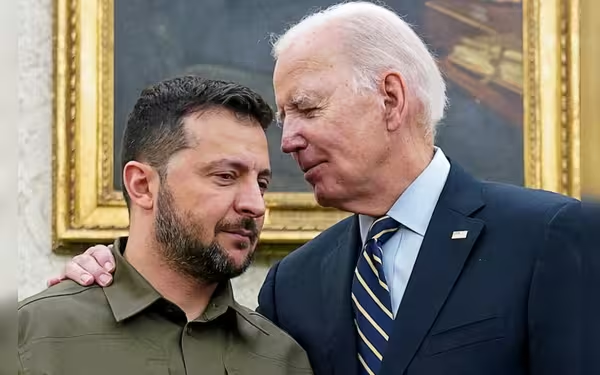Saturday, September 28, 2024 10:22 PM
Biden and NATO's Aggressive Stance Towards Russia
- Zelensky's visit signals U.S. military escalation.
- Concerns rise over potential nuclear conflict.
- NATO's involvement raises stakes in Ukraine.
 Image Credits: asiatimes
Image Credits: asiatimesZelensky's visit to Washington raises concerns over U.S. and NATO's aggressive military stance against Russia amid escalating tensions.
The ongoing conflict between Ukraine and Russia has escalated to alarming levels, particularly with the recent developments surrounding Ukrainian President Volodymyr Zelensky’s upcoming visit to Washington. This visit is not just a routine diplomatic engagement; it is being interpreted as a significant step towards a more aggressive stance by the United States and NATO against Russia. The implications of this meeting could be profound, as it is expected that discussions will revolve around setting specific military targets within Russian territory.
Many analysts are expressing grave concerns about this situation. The idea that the U.S. and NATO are effectively declaring war on Russia is not taken lightly. The potential for this to spiral into a larger conflict, possibly even World War III, is a fear that looms large over international relations today. The rhetoric surrounding the use of long-range missiles against Russia is particularly troubling. Critics argue that such actions are reckless and could provoke a severe response from Moscow.
Russian President Vladimir Putin has made it clear that he views the deployment of missiles in Ukraine as a direct threat. He has pointed out that while these missiles may be stationed in Ukraine, they will be operated by NATO personnel, who will also be responsible for the targeting data provided by American satellites. This raises the stakes significantly, as it suggests a direct involvement of NATO forces in the conflict.
The upcoming meeting between Zelensky and U.S. President Joe Biden is expected to include Vice President Kamala Harris, which adds another layer of complexity to the situation. The stakes are incredibly high, and the potential outcomes are uncertain. Will Russia respond with nuclear weapons? Could we see a scenario where American satellites are targeted? Or might Russia retaliate by striking supply depots in Europe, particularly in Poland, which serves as a crucial hub for military supplies to Ukraine?
Moreover, the possibilities do not end there. Russia could potentially transfer nuclear weapons to allies such as Iran or Syria, further complicating an already tense geopolitical landscape. The world watches with bated breath as these developments unfold, understanding that the decisions made in the coming days could have far-reaching consequences.
The situation between the U.S., NATO, and Russia is precarious. The potential for escalation is significant, and the international community must tread carefully. As citizens of the world, it is essential to stay informed and engaged with these developments, as they not only affect the nations involved but also have implications for global peace and security. The hope remains that diplomacy will prevail over conflict, but the path forward is fraught with challenges.













